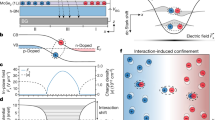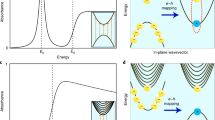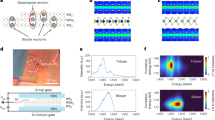Abstract
A light-hole exciton is a quasiparticle formed from a single electron bound to a single light hole. This type of fundamental excitation, if confined inside a semiconductor quantum dot, could be advantageous in quantum information science and technology. However, it has been difficult to access it so far, because confinement and strain in conventional quantum dots favour a ground-state single-particle hole with a predominantly heavy-hole character. Here we demonstrate the creation of a light-hole exciton ground state by applying elastic stress to an initially unstrained quantum dot. Its signature is clearly distinct from that of the well-known heavy-hole exciton and consists of three orthogonally polarized bright optical transitions and a fine-structure splitting of hundreds of microelectronvolts between in-plane and out-of-plane components. This work paves the way for the exploration of the fundamental properties and of the potential relevance of three-dimensionally confined light-hole states in quantum technologies.
This is a preview of subscription content, access via your institution
Access options
Subscribe to this journal
Receive 12 print issues and online access
$209.00 per year
only $17.42 per issue
Buy this article
- Purchase on Springer Link
- Instant access to full article PDF
Prices may be subject to local taxes which are calculated during checkout





Similar content being viewed by others
References
Zrenner, A. et al. Coherent properties of a two-level system based on a quantum-dot photodiode. Nature 418, 612–614 (2002).
Ramsay, A. J. A review of the coherent optical control of the exciton and spin states of semiconductor quantum dots. Semicond. Sci. Technol. 25, 103001 (2010).
Greilich, A. et al. Mode locking of electron spin coherences in singly charged quantum dots. Science 313, 341–345 (2006).
Press, D., Ladd, T. D., Zhang, B. & Yamamoto, Y. Complete quantum control of a single quantum dot spin using ultrafast optical pulses. Nature 456, 218–221 (2008).
Nowack, K. C., Koppens, F. H. L., Nazarov, Y. V. & Vandersypen, L. M. K. Coherent control of a single electron spin with electric fields. Science 318, 1430–1433 (2007).
Laurent, S. et al. Electrical control of hole spin relaxation in charge tunable InAs/GaAs quantum dots. Phys. Rev. Lett. 94, 147401 (2005).
Gerardot, B. D. et al. Optical pumping of a single hole spin in a quantum dot. Nature 451, 441–444 (2008).
Greve, K. D. et al. Ultrafast coherent control and suppressed nuclear feedback of a single quantum dot hole qubit. Nature Phys. 7, 872–878 (2011).
Michler, P. et al. A quantum dot single-photon turnstile device. Science 290, 2282–2285 (2000).
Akopian, N. et al. Entangled photon pairs from semiconductor quantum dots. Phys. Rev. Lett. 96, 130501 (2006).
Salter, C. L. et al. An entangled-light-emitting diode. Nature 465, 594–597 (2010).
Vrijen, R. & Yablonovitch, E. A spin-coherent semiconductor photo-detector for quantum communication. Physica E 10, 569–575 (2001).
Sleiter, D. & Brinkman, W. F. Using holes in GaAs as qubits: An estimate of the Rabi frequency in the presence of an external rf field. Phys. Rev. B 74, 153312 (2006).
Kosaka, H. et al. Spin state tomography of optically injected electrons in a semiconductor. Nature 457, 702–705 (2009).
Reiter, D. E., Kuhn, T. & Axt, V. M. Coherent control of a single Mn spin in a quantum dot via optical manipulation of the light hole exciton. Phys. Rev. B 83, 155322 (2011).
Schmidt, K. H., Medeiros-Ribeiro, G., Oestreich, M., Petroff, P. M. & Döhler, G. H. Carrier relaxation and electronic structure in InAs self-assembled quantum dots. Phys. Rev. B 54, 11346–11353 (1996).
Karlsson, K. F. et al. Fine structure of exciton complexes in high-symmetry quantum dots: Effects of symmetry breaking and symmetry elevation. Phys. Rev. B 81, 161307(R) (2010).
Besombes, L., Kheng, K. & Martrou, D. Exciton and biexciton fine structure in single elongated islands grown on a vicinal surface. Phys. Rev. Lett. 85, 425–428 (2000).
Belhadj, T. et al. Impact of heavy hole-light hole coupling on optical selection rules in GaAs quantum dots. Appl. Phys. Lett. 97, 051111 (2010).
Li, L. et al. Control of polarization and dipole moment in low-dimensional semiconductor nanostructures. Appl. Phys. Lett. 95, 221116 (2009).
Ridha, P. et al. Polarization properties of columnar quantum dots: Effects of aspect ratio and compositional contrast. IEEE J. Quant. Electron. 46, 197–204 (2010).
Troncale, V., Karlsson, K. F., Pelucchi, E., Rudra, A. & Kapon, E. Control of valence band states in pyramidal quantum dot-in-dot semiconductor heterostructures. Appl. Phys. Lett. 91, 241909 (2007).
Huo, Y. H., Rastelli, A. & Schmidt, O. G. Ultra-small excitonic fine structure splitting in highly symmetric quantum dots on GaAs(001) substrate. Appl. Phys. Lett. 102, 152105 (2013).
Owen, D. L., Lackner, D., Pitts, O. J., Watkins, S. P. & Mooney, P. M. In-place bonding of GaAs/InGaAs/GaAs heterostructures to GaAs(001). Semicond. Sci. Technol. 24, 035011 (2009).
Zander, T. et al. Epitaxial quantum dots in stretchable optical microcavities. Opt. Express 17, 22452–22461 (2009).
Ding, F. et al. Tuning the exciton binding energies in single self-assembled InGaAs/GaAs quantum dots by piezoelectric-induced biaxial stress. Phys. Rev. Lett. 104, 067405 (2010).
Bir, G. L. & Pikus, G. E. Symmetry and Strain-induced Effects in Semiconductors (Wiley, 1974).
Meier, F. & Zakharchenva, B. P. (eds) Optical Orientation (Modern Physics in Condensed Matter Science, Vol 8, Elsevier Science, 1984).
Bayer, M. et al. Fine structure of neutral and charged excitons in self-assembled In(Ga)As/(Al)GaAs quantum dots. Phys. Rev. B 65, 195315 (2002).
Witek, B. J. et al. Measurement of the g-factor tensor in a quantum dot and disentanglement of exciton spins. Phys. Rev. B 84, 195305 (2011).
Bester, G., Nair, S. & Zunger, A. Pseudopotential calculation of the excitonic fine structure of million-atom self-assembled In1−xGaxAs/GaAs quantum dots. Phys. Rev. B 67, 161306(R) (2003).
Bester, G. Electronic excitations in nanostructures: An empirical pseudopotential based approach. J. Phys. Condens. Matter 21, 023202 (2009).
Rastelli, A. et al. Hierarchical self-assembly of GaAs/AlGaAs Quantum dots. Phys. Rev. Lett. 92, 166104 (2004).
Tonin, C. et al. Polarization properties of excitonic qubits in single self-assembled quantum dots. Phys. Rev. B. 85, 155303 (2012).
Trotta, R. et al. Nanomembrane quantum-light-emitting diodes integrated onto piezoelectric actuators. Adv. Mater. 24, 2668–2672 (2012).
Acknowledgements
We acknowledge P. Atkinson, Ch. Deneke, D. J. Thurmer and R. Engelhard for assistance with the molecular beam epitaxy, D. Grimm, B. Martin and S. Harazim for assistance in clean room maintenance, and G. Katsaros and R. Rezaev for fruitful discussions. This work was financially supported by the BMBF project QuaHL-Rep (Contracts no. 01BQ1032 and 01BQ1034), the DFG FOR730, the FOM (VIDI Grant), the European Union Seventh Framework Programme 209 (FP7/2007-2013) under Grant Agreement No. 601126 210 (HANAS) and the ERANET project QOptInt.
Author information
Authors and Affiliations
Contributions
Y.H.H. grew and processed samples, measured micro-photoluminescence, and analysed data supported by S.K., J.X.Z., E.Z., R.T. and F.D., under supervision of A.R. and O.G.S. B.J.W. carried out micro-photoluminescence in magnetic field supported by N.A. and V.Z. and provided insightful interpretation of the experimental and theoretical results. J.R.C., R.S. and G.B. performed pseudopotential calculations and developed the mesoscopic model. R.G., D.K. and J.S. performed X-ray diffraction measurements. All authors discussed the results and contributed to the manuscript. A.R. conceived and coordinated the project, triggered by V.Z. and N.A.
Corresponding authors
Ethics declarations
Competing interests
The authors declare no competing financial interests.
Supplementary information
Supplementary Information
Supplementary Information (PDF 3926 kb)
Rights and permissions
About this article
Cite this article
Huo, Y., Witek, B., Kumar, S. et al. A light-hole exciton in a quantum dot. Nature Phys 10, 46–51 (2014). https://doi.org/10.1038/nphys2799
Received:
Accepted:
Published:
Issue Date:
DOI: https://doi.org/10.1038/nphys2799
This article is cited by
-
Approaching a fully-polarized state of nuclear spins in a solid
Nature Communications (2024)
-
Preparing the photo- and heat-stable PGMA/CdTe quantum dot composite films and exploring devices for LED-display poster design
Chemical Papers (2024)
-
Nuclear spin quantum register in an optically active semiconductor quantum dot
Nature Nanotechnology (2020)
-
Droplet epitaxy of semiconductor nanostructures for quantum photonic devices
Nature Materials (2019)
-
Effect of Lateral Electric Field on the Transition Energies of Heavy Hole State and Light Hole State in a Semiconductor Quantum Dot
Journal of Electronic Materials (2019)



